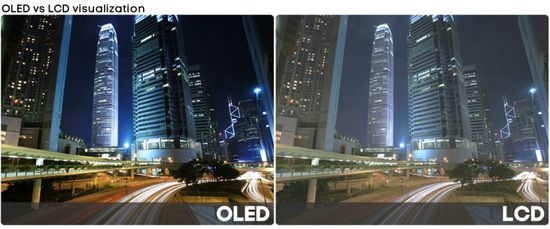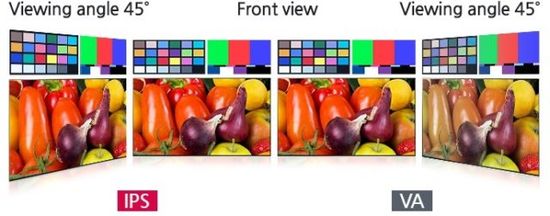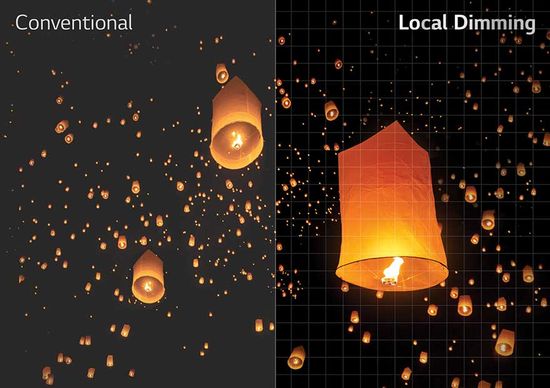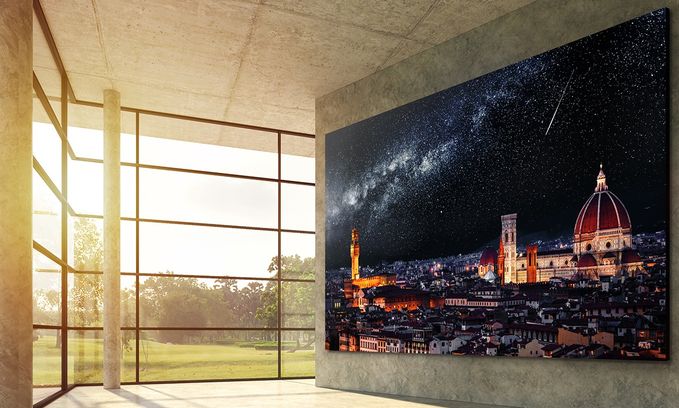Today, the segment of high-tech TVs is characterized by one of the highest competition level, which forces companies to actively improve their products. As a result, industry leaders annually introduce innovative TVs.
Of course, the consumer value of any modern TV depends on many factors, including resolution, viewing angles, browser, sound quality, input lag in games, etc. But image quality remains the main criterion. In turn, it directly depends on the contrast and brightness of the panel.
Today the Internet offers such information. For example, the reputable Rtings.com regularly publishes great diagnostic reports for most of the popular models. But using them requires minimal knowledge of these specs.
Contrast ratio
The contrast ratio is the ratio between the brightest white and the darkest black on the screen. The luminance of white and black is measured in nits or in cd/m². The measuring uses a black and white checkerboard pattern.

The luminance meter accurately measures the luminance of center white square with pre-calibration of about 100 nits, and of the four surrounding black squares. Then the average value is calculated. For example, contrast is 2,500: 1 with 100 nits white and 0,04 nits black.
A more accurate method based on ANSI checkerboard pattern measures luminance in 16 squares.
The higher contrast ratio improves the display of dark gradations.

For example, a spy in a black raincoat and black glasses who sneaks around the city at night will look like a blurry gray spot when viewed on low-contrast TV, especially in a dark room. But this problem diminishes significantly when viewed in a brightly lit room.
As known, OLED panels use self-emitting LEDs without backlit. They can turn individual pixels on and off, providing perfect blacks when turned off (zero black level).

LCD panel with backlit cannot provide perfect blacks due to partial passage of the light flux even through “closed” liquid crystals. As a result, scattered light from backlit degrades the black level, decreasing the contrast ratio.
As known, modern LCD TVs use IPS (In-Plane Switching) and VA (Vertical Alignment) panels. VA technology is more efficient at blocking off light and provides higher contrast. IPS panels have less contrast, but provide wider viewing angles.

Today, companies are increasingly using ADS panel, which is improved version of IPS panel.
Dynamic & native contrast ratio
Highly efficient Local Dimming technology has dramatically increased contrast.

As known, it changes the backlit intensity in different areas of the frame depending on the content. As a result, the developers began to use the “dynamic contrast ratio” term. In fact, it means the contrast of the LCD panel using local dimming based on FALD (Full Array Local Dimming) or a super innovative mini LED backlit with a huge number of individually controllable zones.
The pros of local dimming are especially evident in dark scenes in a dark room. Of course, its performance vary considerably between models. For example, local dimming in Samsung QN90A with mini LED increases the contrast ratio from 3,500: 1 to 26,500: 1, and in Vizio P Series Quantum X 2020 – from 5,000: 1 to 14,300: 1.
Unfortunately, not a very good job of this function in some mid-budget models causes halo around bright objects in dark scenes or dimming the entire image.
The native contrast measures the contrast ratio without additional image processing settings. 3,000 or more is considered good value for modern TVs. Visually, the eye perceives the difference when it changes by 500 in any direction.
Brightness
The screen brightness depends on the panel and provides not dim image even in a brightly lit room. In addition, it’s necessary for displaying small highlights in HDR.
Testing is usually done for SDR and HDR modes in few white rectangles with different surface areas. Of course, HDR brightness is significantly higher vs SDR brightness. High brightness is especially important for bright living rooms, bright objects and HDR content. But increasing the brightness is almost always reduces color accuracy.
HDR / SDR real scene peak brightness
Displaying HDR content in high quality requires brightness from 650 nits and above, a noticeable difference occurs when changing by about 80 nits. SDR content requires 365 nits and higher brightness.
SDR / HDR peak window
– 2% – the maximum luminosity of a white square covering 2% of the screen with max TV’s bright. It characterizes the max brightness of a small highlight, for example, the sun, a distant explosion, etc and is especially important for HDR performance.

– 10%, 25%, 50% and 100% window test patterns show TV’s brightness across different content.

Good value is from 650 nits for HDR and from 365 nits for SDR.
SDR / HDR sustained window
This is a lowest max luminosity of a stabilized white 10%- window with local dimming. In fact, it coincides with the peak window and confirms stable TV performance when displaying persistent bright objects. Some budget models dim when displaying a bright image for a long time.
Modern TVs often use ABL (Auto brightness limiter), which is unfortunately not adjustable. It’s usually activated for content with large areas of bright colors, for example, in bright colored cartoons.
Conclusion
Tough competition is driving an innovation boom in the high-tech TVs segment. Quantum Dot (QD) technology, including Samsung’s QLED, LG’s Nano Cell, Sony’s Triluminos and Hisense’s ULED, Local Dimming based on FALD or mini LED backlit, including Samsung’s Neo QLED, LG’s QNED and TCL’s OD-Zero TVs, Hisense’s latest super promising Dual Cell technology and brighter (up to 1,000 nits) OLED Evo panel in LG G1 series perfectly illustrate this trend.
QD expands the color gamut and enhances color accuracy, while other technologies improve contrast and brightness.
In principle, brightness from 650 nits and above is quite sufficient for acceptable HDR performance. SDR content requires only 350 nits. Today, even many mid-range models meet these requirements.
The panel contrast is increased quite effectively with local dimming. But even without this feature, modern TVs rarely have a contrast of less than one to several thousand, which is quite enough for comfortable viewing even with ambient light in the living room.
But, of course, today these specs are maximum in the latest LG Evo OLED G1 (“infinite contrast” & 1,000 nits brightness) and the Samsung Neo QN90A with mini LED backlit (1,800 nits peak brightness).
This video demonstrates the contrast with Mini LED backlit.
